Pentium 4
For example, in mathematical applications, AMD's lower-clocked Athlon (the fastest-clocked model was clocked at 1.2 GHz at the time) easily outperformed the Pentium 4, which would only catch up if software was re-compiled with SSE2 support.Computer-savvy buyers avoided Pentium 4 PCs due to their price premium, questionable benefit, and initial restriction to Rambus' RDRAM.While IPC is difficult to quantify due to dependence on the benchmark application's instruction mix, clock speed is a simple measurement yielding a single absolute number.Because AMD's processors had slower clock speeds, it countered Intel's marketing advantage with the "megahertz myth" campaign.AMD product marketing used a "PR-rating" system, which assigned a merit value based on relative performance to a baseline machine.At the launch of the Pentium 4, Intel stated that NetBurst-based processors were expected to scale to 10 GHz[15] after several fabrication process generations.Intel had not anticipated a rapid upward scaling of transistor power leakage that began to occur as the die reached the 90 nm lithography and smaller.On January 5, 2006, Intel launched the Core processors, which put greater emphasis on energy efficiency and performance per clock cycle.[17] Pentium 4 processors have an integrated heat spreader (IHS) that prevents the die from accidentally being damaged when mounting and unmounting cooling solutions.Willamette, the project codename for the first NetBurst microarchitecture implementation, experienced long delays in the completion of its design process.[18] Although introduced at prices of $644 (1.4 GHz) and $819 (1.5 GHz) for 1000 quantities to OEM PC manufacturers[citation needed] (prices for models for the consumer market varied by retailer), it sold at a modest but respectable rate, handicapped somewhat by the requirement for relatively fast yet expensive Rambus Dynamic RAM (RDRAM).In January 2001, a still slower 1.3 GHz model was added to the range, but over the next twelve months, Intel gradually started reducing AMD's leadership in performance.The battle for performance leadership remained competitive (as AMD introduced faster versions of the Athlon XP) but most observers agreed that the fastest-clocked Northwood-based Pentium 4 was usually ahead of its rival.[citation needed] This was particularly so in mid-2002, when AMD's changeover to its 130 nm production process did not help the initial "Thoroughbred A" revision Athlon XP CPUs to clock high enough to overcome the advantages of Northwood in the 2.4 to 2.8 GHz range.While core voltage approaching 1.7 V and above would often allow substantial additional gains in overclocking headroom, the processor would slowly (over several months or even weeks) become more unstable over time with a degradation in maximum stable clock speed before dying and becoming totally unusable.The design was mostly identical to Pentium 4 (to the extent that it would run in the same motherboards), but differed by an added 2 MB of level 3 cache.Nonetheless, the Extreme Edition did achieve Intel's apparent aim, which was to prevent AMD from being the performance champion with the new Athlon 64, which was winning every single major benchmark over the existing Pentium 4s.By most metrics, this was on a per-clock basis the fastest single-core NetBurst processor that was ever produced, even outperforming many of its successor chips (not counting the dual-core Pentium D).Although never a particularly good seller, especially since it was released in a time when AMD was asserting near total dominance in the processor performance race, the Pentium 4 Extreme Edition established a new position within Intel's product line, that of an enthusiast oriented chip with the highest-end specifications offered by Intel chips, along with unlocked multipliers to allow for easier overclocking.Contrary to popular belief, however, the Socket 478 versions of the Pentium 4 Extreme Edition CPUs such as the Gallatin-based Pentium 4 Extreme Edition for Socket 478 all have a locked multiplier, meaning that they are not overclockable unless the front-side bus speeds are increased (which runs the potential risks of erratic behaviors such as reliability and stability issues).Prescott's inability to achieve greater clock speeds was attributed to the very high power consumption and heat output of the processor.[31] In fact, Prescott's power and heat characteristics were only slightly higher than those of Northwood of the same speed and nearly equal to the Gallatin-based Extreme Editions, but since those processors had already been operating near the limits of what was considered thermally acceptable, this still posed a major issue.Tests showed that a given Pentium 4 made for LGA 775 consumed more power and produced more heat than the exact same chip in a socket 478 package.The BTX form factor, meanwhile, showed signs of having been designed for the sole purpose of managing the Prescott's heat output at the expense of other components and concerns, such as blowing hot air from the CPU directly into the graphics card's heatsink/fan.The E-series Prescott, as well as the low-end 517 and 524, incorporates Hyper-Threading in order to speed up some processes that use multithreaded software, such as video editing.This was a die shrink of the Prescott-based 600 series core to 65 nm, with no real feature additions but significantly reduced power consumption.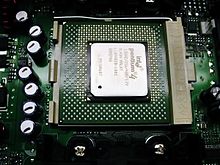
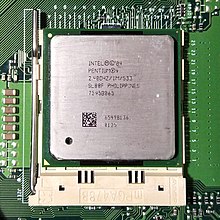


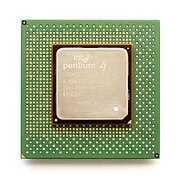

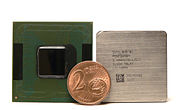
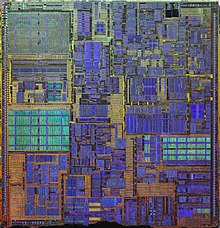

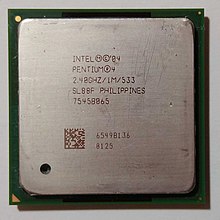

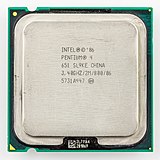
List of Intel Pentium 4 processorsclock rateMicroarchitectureNetBurstInstruction setx86-64TransistorsSocket 423Socket 478LGA 775Pentium IIIPentium MPentium DPentium Dual-CoredesktopslaptopsserversHyper-Threading Technology64-bitNX bitCeleronmulti-socketdual-coreCore 2legacy applicationscode optimizationAthlonmarchitectureinstructions per cycleclock speedbenchmarkmegahertz mythPR-ratingfabrication processtrace cacheHyper-threadingintegrated heat spreaderCPU shimAMD AthlonAMD DuronWillamette Valleyheat spreaderL2 cache130 nmDDR SDRAMOpteronelectromigrationSpeedStepjunction temperatureAthlon 64Athlon 64 FXCore i7Core i9front-side bus90 nm processBTX form factorcopper interconnectstrained siliconlow-κXD bitNX (No eXecute)exploitingbuffer overflowIntel 64Thermal Monitor 264-bit modeVirtualization65 nmCedar Mill, Oregonunincorporated communityHillsboro, OregonCentrinoPentium Extreme EditionEnhanced Pentium MConroeCore microarchitectureList of Intel Pentium processorsList of Intel processorsWayback MachineMicroprocessor ReportAnandTechIntel Core 2Intel processorsProcessorsPentiumItaniumMicroarchitecturesChipsets32-bitP6 variant (Pentium M)P6 variant (Enhanced Pentium M)PenrynNehalemWestmereSandy BridgeIvy BridgeHaswellBroadwellSkylakeCannon LakeSunny CoveCypress CoveWillow CoveGolden CoveBonnellSaltwellSilvermontGoldmontGoldmont PlusTremontGracemont16-bit80C18780387SX80387DXRapidCADOverDriveA100/A110Original i586P6-basedNetBurst-basedCore-basedTolapaiNehalem-basedSandy Bridge-basedIvy Bridge-based